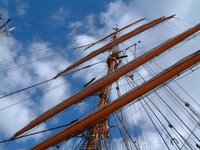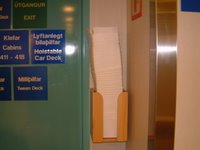Gabe and Pete are sleeping, so John and I head out of town, down the same road we took two days ago to Thingvellir. It's our last day in Reykjavik, unless we decide to return on the day before we leave Iceland. We don't want to waste time: already we are faced with the unfortunate fact of not having visited one museum in Reykjavik! (A good wintertime activity? Reasons for returning to Iceland #2 and #3: Reykjavik museums and the Northern Lights.)
So today we are going to visit Gljufrasteinn, the home and museum of author Halldor Laxness. Thingvellir, Gljufrasteinn, and Drangey Island are the top three personal shrines on my Iceland list.
Halldor Laxness (1902-1998) won the Nobel prize in 1955, in part for his book Independent People. In an introduction to this book Brad Leithauser says:
When I tell people I meet that my favorite book by a living novelist is Halldor Laxness's Independent People and am asked what it's about, my reply is, "Sheep."We come close to hitting a herd of sheep on the road, one at a time. In case you're curious, sheep are not too smart. They exhibit that irritating characteristic common to squirrels and deer: it's impossible to predict which way they will dash when they panic--or they might just freeze. It's safer not to honk the horn, and just wait for them to amble off.
...My reply is actually less facetious than might first appear, for while the book does keep large issues constantly in mind (the largest: mortality and memory and love and duty), it is also very much about...[sheep].
Gljúfrasteinn is nestled in a large, lovely valley with imposing mountains nearby, across the road from Laxnes horse farm. Laxness's name, a pseudonym he took in 1923, means "of Laxnes."

First we walk around through the gardens to the back of the house, and have our picnic lunch on a bench in an alcove shaded by small birches and wildflowers. The nearby stream tumbles over smooth boulders and forms myriad small waterfalls.
The house itself is elegantly plain: medium sized, white plaster with lots of windows. It isn't a showplace; it's a house meant to be lived in. The orginal furnishings, art, music and books are still in place, so it's very easy to imagine Laxness and his family living here. The audio tour is excellent: it is less obtrusive than a tour guide, and the recording includes the voices of Laxness and his wife. You can stand in his study, see the desk he stood at to write, look out the window at the very view that he saw daily. You can enter his bedroom, and see the art and objects he kept close to him. You can see his Steinway piano--the very same one that Bill Holm has played. When I see the grandfather clock in the hallway--ticking et-ERN-it-Y---(the one that the clock in The Fish Can Sing was modeled on) my throat closes up and I choke back tears.
We have an interesting talk with a man who works in the visitors center about our favorite Laxness books, and about movie versions of them. They have many copies of his books for sale, in a variety of languages. I would next like to read: Salka Valka, The Atom Station, and the story about Mosfellskirkja.
As we drive back to Reykjavik, we see (for the first time) the snow-covered mountain Snaefellsjokull in the far distance. You can't always see this from Reykjavik, but it's a beautiful sight. This is the glacier that Jules Verne used for the setting of Journey to the Centre of the Earth, and it is believed to be one of the world's most powerful and spiritual places.
Back to town, it's time to each lunch and pack up. We go with Gabe and Peter down to the harbor to eat at Tommy Burger. I have an absolutely delicious veggie burger accompanied by a coffee milkshake. What makes the veggie burger so good is that they use a mix similar to what is used for felafels, and it really works. Try it yourself!
 It's a sunny day in Reykjavik which means that, even though the temperature is only about 60°F, many of the natives are walking around in shorts and sandals, eager to soak up the sun. We find a large, four-masted schooner docked in the harbor, and as we approach it we find that it is a Russian training vessel, the shipmates are offering tours, and the tours are free! We take one.
It's a sunny day in Reykjavik which means that, even though the temperature is only about 60°F, many of the natives are walking around in shorts and sandals, eager to soak up the sun. We find a large, four-masted schooner docked in the harbor, and as we approach it we find that it is a Russian training vessel, the shipmates are offering tours, and the tours are free! We take one.
 Leaving Reykjavik we have a 45-minute drive to catch the ferry for the Westmann Islands, where we will be staying on Heimaey. Our ferry trip is almost 3 hours. We admire features of our ferry, Herjolfur. First, we observe a stack of containers that look like large chinese take-out boxes. We suspect that these are conveniently provided for when the seas aren't so smooth as they are today. Convenient! Plus, we discover original art hung throughout the ship: oils, watercolors, photographs. Many of them feature Icelandic landscapes, and are quite good.
Leaving Reykjavik we have a 45-minute drive to catch the ferry for the Westmann Islands, where we will be staying on Heimaey. Our ferry trip is almost 3 hours. We admire features of our ferry, Herjolfur. First, we observe a stack of containers that look like large chinese take-out boxes. We suspect that these are conveniently provided for when the seas aren't so smooth as they are today. Convenient! Plus, we discover original art hung throughout the ship: oils, watercolors, photographs. Many of them feature Icelandic landscapes, and are quite good.As we approach the fourteen Westmann Islands, they emerge as unique, odd shapes on the horizon that become steadily more bizarre as we approach. Like Iceland, these are volcanic islands, and our destination, Heimaey, is the only one that is inhabitated, unless you count sheep. Count sheep? We're not even tired yet!
The sheer black/green cliffs of Heimaey are beautiful, with birds everywhere as we come in to
 the harbor at 10:45 p.m. We disembark and walk through the quiet town until we find Guesthouse Hrithrith, and meet the German owner Ruth, who gives tours to the volcano and bakes bread there in the hot lava. (She is a full-time baker in the winter.) We have interesting midnight conversations in the guesthouse kitchen with a geologist from Scotland and a Chinese translator and his friend from the UK.
the harbor at 10:45 p.m. We disembark and walk through the quiet town until we find Guesthouse Hrithrith, and meet the German owner Ruth, who gives tours to the volcano and bakes bread there in the hot lava. (She is a full-time baker in the winter.) We have interesting midnight conversations in the guesthouse kitchen with a geologist from Scotland and a Chinese translator and his friend from the UK.John and Gabe go for separate midnight walks on Heimaey. John walks by the cemetary without incident, and then to the lava area. Back at the guesthouse, the boys and I compare the cool features of our different sleeping bags. Gabe wins, with his "Penguin" bag. (That's not the name of the bag, but just that he looks like a penguin in it due to the color design. We offer to get him an orange bill and feet so we can rename it the Puffin bag.)
High 60°F Low 48°F
No comments:
Post a Comment